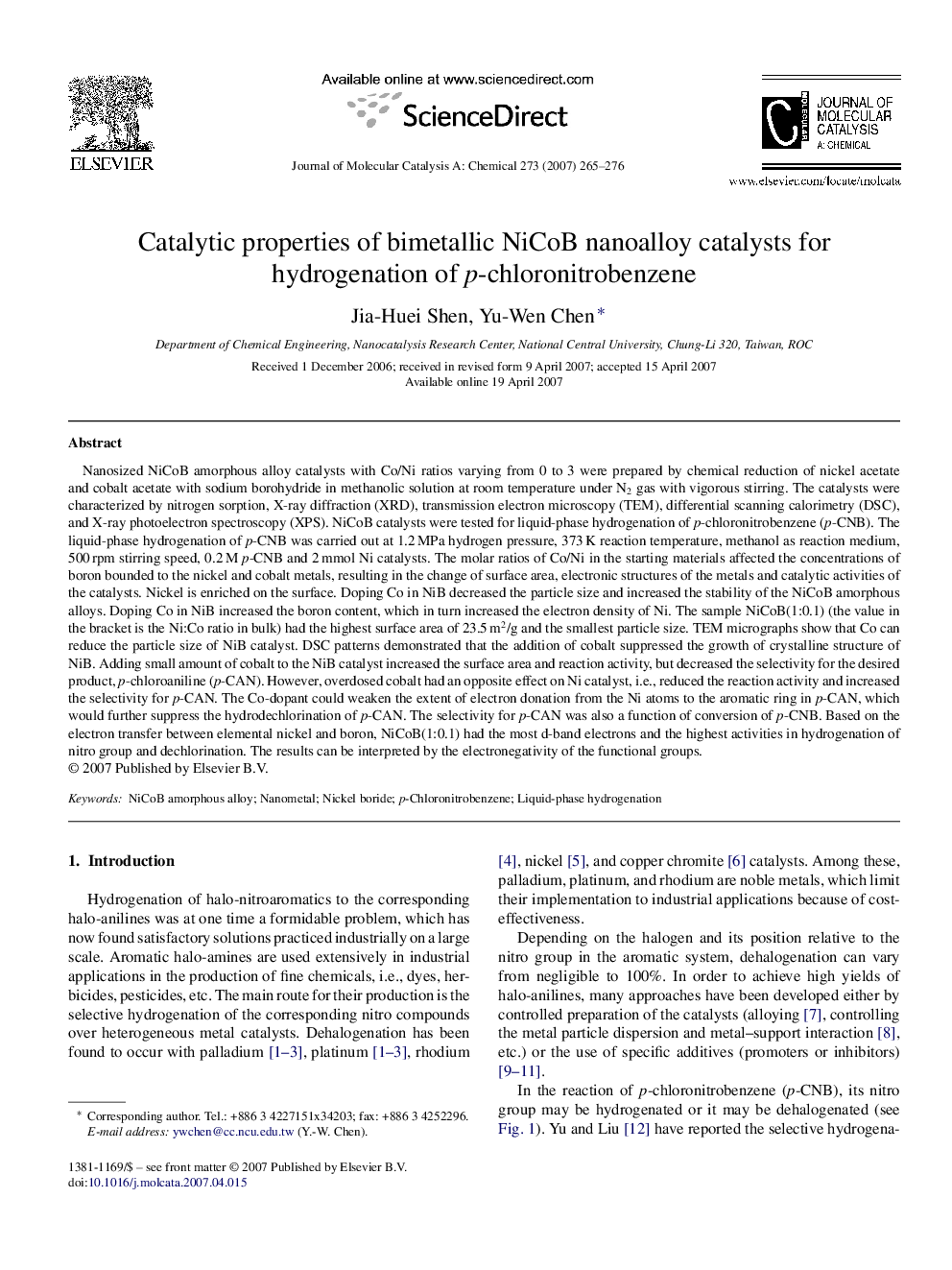| کد مقاله | کد نشریه | سال انتشار | مقاله انگلیسی | نسخه تمام متن |
|---|---|---|---|---|
| 67901 | 48497 | 2007 | 12 صفحه PDF | دانلود رایگان |

Nanosized NiCoB amorphous alloy catalysts with Co/Ni ratios varying from 0 to 3 were prepared by chemical reduction of nickel acetate and cobalt acetate with sodium borohydride in methanolic solution at room temperature under N2 gas with vigorous stirring. The catalysts were characterized by nitrogen sorption, X-ray diffraction (XRD), transmission electron microscopy (TEM), differential scanning calorimetry (DSC), and X-ray photoelectron spectroscopy (XPS). NiCoB catalysts were tested for liquid-phase hydrogenation of p-chloronitrobenzene (p-CNB). The liquid-phase hydrogenation of p-CNB was carried out at 1.2 MPa hydrogen pressure, 373 K reaction temperature, methanol as reaction medium, 500 rpm stirring speed, 0.2 M p-CNB and 2 mmol Ni catalysts. The molar ratios of Co/Ni in the starting materials affected the concentrations of boron bounded to the nickel and cobalt metals, resulting in the change of surface area, electronic structures of the metals and catalytic activities of the catalysts. Nickel is enriched on the surface. Doping Co in NiB decreased the particle size and increased the stability of the NiCoB amorphous alloys. Doping Co in NiB increased the boron content, which in turn increased the electron density of Ni. The sample NiCoB(1:0.1) (the value in the bracket is the Ni:Co ratio in bulk) had the highest surface area of 23.5 m2/g and the smallest particle size. TEM micrographs show that Co can reduce the particle size of NiB catalyst. DSC patterns demonstrated that the addition of cobalt suppressed the growth of crystalline structure of NiB. Adding small amount of cobalt to the NiB catalyst increased the surface area and reaction activity, but decreased the selectivity for the desired product, p-chloroaniline (p-CAN). However, overdosed cobalt had an opposite effect on Ni catalyst, i.e., reduced the reaction activity and increased the selectivity for p-CAN. The Co-dopant could weaken the extent of electron donation from the Ni atoms to the aromatic ring in p-CAN, which would further suppress the hydrodechlorination of p-CAN. The selectivity for p-CAN was also a function of conversion of p-CNB. Based on the electron transfer between elemental nickel and boron, NiCoB(1:0.1) had the most d-band electrons and the highest activities in hydrogenation of nitro group and dechlorination. The results can be interpreted by the electronegativity of the functional groups.
Adding small amount of cobalt in the NiB catalysts increased the surface area and reaction activity, but decreased the selectivity for the desired product, p-CAN. However, overdosed cobalt had an opposite effect on the Ni catalyst, it reduced the reaction activity but increased the selectivity for p-CAN.Figure optionsDownload as PowerPoint slide
Journal: Journal of Molecular Catalysis A: Chemical - Volume 273, Issues 1–2, 1 August 2007, Pages 265–276